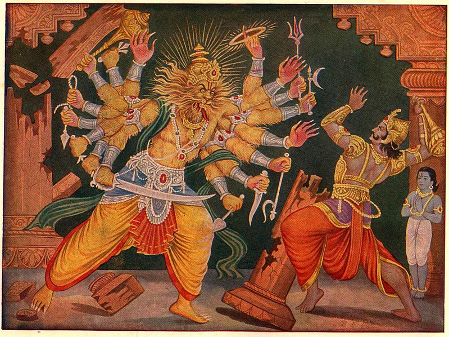NIHAL SINGH DAMDAMIAN, 19th century Nirmala saint, a native of Mimsa village of the former princely state of Patiala, received initiation and religious education at the hands of Mahant Dunna Singh, of Uchcha Buriga, a Nirmala sanctuary at Damdama Sahib, Talvandi Sabo, in present day Bathinda district, and became head of the Buriga after the latter`s death. He was respected for his humility and unassuming nature and for the zeal with which he served in the Guru ka Larigar and the loving care with which he looked after the cattle in the shed. In 1860, he with a band of youthful devotees, went to Dera Baba Ram Rai in Dehra Dun and, felling one of the tallest trees in the pine forest of its extensive estate, brought it to Talvandi Sabo carrying it on their heads all the way to Patiala and thence on bullock carts arranged by Maharaja Narinder Singh of Patiala to Damdama Sahib where it was put up as the religious flagmast. Reaching Damdama Sahib, Nihal Singh humbly stood at the entrance where the sangat had deposited their shoes and would not enter the Takht Sahib until he had obtained pardon by paying penalty for having violated the Sikh code of conduct forbidding any dealings with the followers of Baba Ram Rai.
NIRANJANIE, also called Handalie, was an heretic cult rounded by Handal (1573-1646) of Jandiala in Amritsar district, a former follower of Sultan SakhT Sarwar, who became a Sikh in the time of GuruAmar Das. He served in the Guru ka Larigar. Pleased with his devotion, the Guru appointed him a preacher in his native Jandiala and the surrounding area. People admired him for his simple ways. Handal attracted many followers. But as time passed, he grew very vain and appropriated unto himself the status of Guru and started calling himself Nirarijania, i.e. one who had overcome his illusion.
NAULAKKHA, a village about 20 km north of Patiala (30° 20`N, 76° 26`E), has a gurdwara dedicated to the memory of Guru Tegh Bahadur who visited the site during one of his journeys across the Malva region. The shrine was managed for a long time by a line of mahants from whom the village Sikh community secured prossession of it during the days of the Gurdwara Reform movement of the 1920`s. The old building was replaced by a new one in 1991 Bk/AD 1934. This present building is constructed around a domed sanctum. The Guru ka Langar is close by. The shrine is managed by a local committee under the auspices of the Shiromani Gurdwara Parbandhak Committee.
NIHAL SINGH KAIRON (1863-1928), a pioneer of women`s education in the Punjab, was born on 22 December 1863 at Kairori, a village in Amritsar district. His father, Gulab Singh, a deeply religious person, had three sons, Nihal Singh being the youngest of them. Nihal Singh had no formal schooling, and travelled with his brother, Tarlok Singh, to Malaya (Malaysia) while still very young. He joined the Royal Artillery at Hong Kong, but soon secured his release and returned to his village in the Punjab to work for community welfare and reform. He lectured at Singh Sabha divans.
NIRANKARIS, a sect of the Sikhs born of a reform movement which arose in northwest Punjab in the middle of the nineteenth century aiming to restore the purity of Sikh belief and custom. Its founder, Baba Dayal (1783-1855), was a contemporary of Maharaja Ranjit Singh. A man of humble origin, he cavilled at the shortcomings of the mighty and assailed the rites and observances which had perverted the Sikh way of life. His main target was the worship of images against which he preached vigorously.






